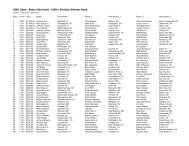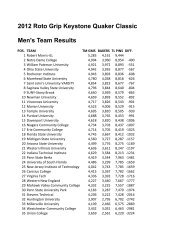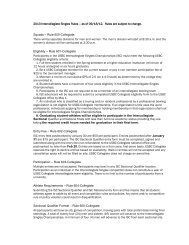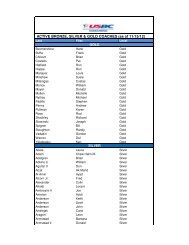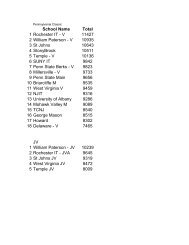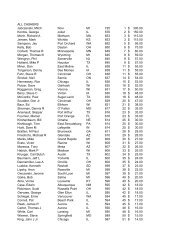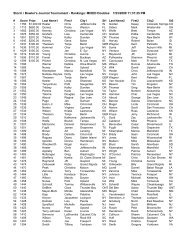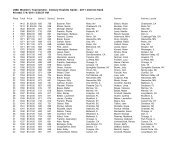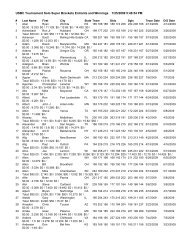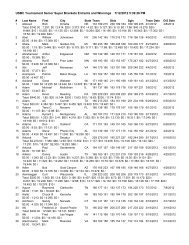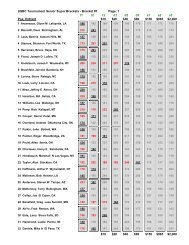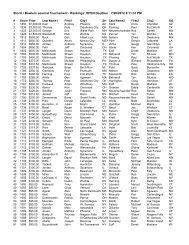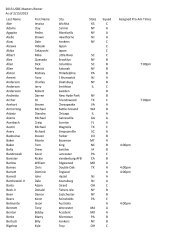of Asymmetrical Bowling Balls
of Asymmetrical Bowling Balls
of Asymmetrical Bowling Balls
You also want an ePaper? Increase the reach of your titles
YUMPU automatically turns print PDFs into web optimized ePapers that Google loves.
EQUIPMENT SPECIFICATIONS &<br />
CERTIFICATION<br />
Purpose: To determine the RG about the X, Y and Z axes <strong>of</strong> asymmetrically marked bowling<br />
ball.<br />
Materials:<br />
Ball cup<br />
<strong>Bowling</strong> ball to be tested with asymmetrical core markings<br />
<strong>Bowling</strong> Ball Radius <strong>of</strong> Gyration Worksheet which should include calibration<br />
information for the RG Swing being used<br />
Grease Pencil<br />
MoRich DeTerminator<br />
RG Swing with timing mechanism and electric eye counter<br />
<strong>Bowling</strong> ball total weight scale<br />
Turbo 2-N-1 Pro Sect<br />
Procedure:<br />
1. Using SOP-BALL-4, find the total weight <strong>of</strong> the bowling ball.<br />
2. Record the total weight <strong>of</strong> the bowling ball on the “<strong>Bowling</strong> Ball Radius <strong>of</strong> Gyration<br />
Worksheet.”<br />
3. Place the bowling ball in the DeTerminator with the manufacturer’s pin pointing directly<br />
through the eyehole <strong>of</strong> the side arm.<br />
4. Place the point <strong>of</strong> the grease pencil through the eyehole <strong>of</strong> the side arm on the<br />
DeTerminator.<br />
5. Energize the DeTerminator and allow grease pencil to draw a path on the bowling ball as<br />
it spins.<br />
6. Wait until the bowling ball is spinning around about a point and the grease pencil has<br />
clearly marked that point indicating the PSA (Preferred Spin Axis) on the bowling ball.<br />
7. Switch <strong>of</strong>f the DeTerminator.<br />
8. Remove the bowling ball from the DeTerminator and place in a ball cup. See Figure 1<br />
which displays the marked PSA and shows the grease pencil path drawn on the bowling<br />
ball from step 6.<br />
SOP-BALL-1 Rev: 4 07/03/12<br />
0
EQUIPMENT SPECIFICATIONS &<br />
CERTIFICATION<br />
Pin<br />
PSA<br />
Figure 1 - <strong>Asymmetrical</strong> bowling ball just after being spun on the<br />
DeTerminator<br />
9. Align the Pro Sect on the bowling ball so the “0” mark is on the PSA and the end is going<br />
through or towards the pin <strong>of</strong> the bowling ball.<br />
10. Draw a line, using the grease pencil, from the PSA on the bowling ball through or<br />
towards the pin. This line is shown in green in Figure 2. Mark the point 6 ¾’’ from the<br />
PSA towards the pin. This mark characterizes one end <strong>of</strong> the x-axis <strong>of</strong> the bowling ball.<br />
Figure 2 shows the marked PSA and the line drawn 6 ¾’’from the PSA towards the pin <strong>of</strong><br />
the bowling ball.<br />
SOP-BALL-1 Rev: 4 07/03/12<br />
Path drawn<br />
from being on<br />
DeTerminator<br />
1
PSA<br />
EQUIPMENT SPECIFICATIONS &<br />
CERTIFICATION<br />
x-axis point<br />
Figure 2 – The green line drawn 6 ¾’’ from the PSA towards the pin locates one end <strong>of</strong> the x-axis <strong>of</strong> the<br />
bowling ball (the low RG).<br />
11. Draw a line with the grease pencil using the Pro Sect that is perpendicular to the line<br />
drawn in step 10 and highlighted in green in Figure 2 by placing the “0” mark <strong>of</strong> the Pro<br />
Sect on the x-axis marking. Mark one end <strong>of</strong> the z-axis by making a mark with the<br />
grease pencil 6 ¾’’ away from the x-axis point along the line that is perpendicular to the<br />
line drawn in step 10. Figure 3 shows the z-axis point 90 degrees away from the x-axis.<br />
The z-axis point is also mutually perpendicular to the y-axis point (PSA) and the x-axis<br />
point which is further illustrated in Figure 4.<br />
Pin<br />
SOP-BALL-1 Rev: 4 07/03/12<br />
PSA<br />
Figure 3 - The z-axis and the x-axis points are marked on the<br />
bowling ball. The z-axis point is located 6 ¾'' perpendicular<br />
to the line to the x-axis.<br />
x-axis point<br />
2
EQUIPMENT SPECIFICATIONS &<br />
CERTIFICATION<br />
x-axis point<br />
PSA<br />
(y-axis point) z-axis point<br />
Figure 4 - X-axis point, PSA and z-axis point labeled<br />
relative to each other.<br />
12. Supply power to the RG Swing timing mechanism and electric eye counter. Wait for the<br />
display to stop flashing.<br />
13. Place the bowling ball in the RG Swing cradle with the x-axis at the very top pointing up<br />
through the string on the RG Swing. To assist with centering the bowling ball, align the<br />
line from the x-axis to the PSA with the side bar <strong>of</strong> the cradle on the RG swing.<br />
14. Rotate and hold the left side <strong>of</strong> the RG Swing cradle towards you so the left side <strong>of</strong> the<br />
cradle is in front <strong>of</strong> the timing and counting sensor (approximately rotated to the corner<br />
<strong>of</strong> the base <strong>of</strong> the RG swing). Continue to hold the cradle and push the “R” button on the<br />
timing and counting display so the display reads zero.<br />
15. Carefully release the cradle so it rotates smoothly with as little wobble as possible.<br />
16. Allow the bowling ball to “swing” for 5 periods (the timing mechanism and counter will<br />
stop once it reaches 11).<br />
17. Once the timer stops, record the time for 5 periods on the “<strong>Bowling</strong> Ball Radius <strong>of</strong><br />
Gyration Worksheet” for the RG Swing being used under “swing time” for the axis being<br />
tested.<br />
18. Reset the timing mechanism and electric eye counter without stopping the bowling ball<br />
from swinging. The RG swing should be on the same side <strong>of</strong> the counter as it was in step<br />
15.<br />
SOP-BALL-1 Rev: 4 07/03/12<br />
3
19. Repeat steps 16-17.<br />
EQUIPMENT SPECIFICATIONS &<br />
CERTIFICATION<br />
20. If the two swing times recorded for the x-axis have a difference <strong>of</strong> greater than 0.08<br />
seconds, repeat steps 14-20. If not, continue.<br />
21. Stop the bowling ball from swinging and rotate the bowling ball so y-axis point or PSA is<br />
now at the very top pointing up though the string on the RG Swing. To assist with<br />
centering the bowling ball, align line from the x-axis to the PSA with the opposite side<br />
bar <strong>of</strong> the cradle on the RG Swing.<br />
22. Repeat steps 14-19.<br />
23. If the two swing times recorded for the y-axis have a difference greater than 0.08<br />
seconds, repeat steps 14-19 and then step 23. If not, continue.<br />
24. Stop the bowling ball from swinging and rotate the bowling ball in the cradle <strong>of</strong> the RG<br />
Swing so the z-axis point is now at the very top pointing up through the string on the RG<br />
Swing. To assist in centering the bowling ball, align the line from the x-axis to the z-axis<br />
with the side bar <strong>of</strong> the cradle on the RG Swing that is nearest to you.<br />
25. Repeat steps 14-19.<br />
26. If the two swing times recorded for the z-axis have a difference greater than 0.08<br />
seconds, repeat steps 14-19 and then step 26. If not, continue.<br />
27. Once 2 swing times for each axis have been recorded on the “<strong>Bowling</strong> Ball Radius <strong>of</strong><br />
Gyration Worksheet,” the RG for each axis, the differential and the intermediate<br />
differential will be displayed on the worksheet in inches.<br />
SOP-BALL-1 Rev: 4 07/03/12<br />
4




